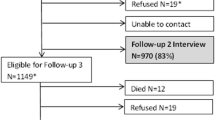Abstract
Residential transience may contribute to adverse mental health. However, to date, this relationship has not been well-investigated among urban, impoverished populations. In a sample of drug users and their social network members (n = 1,024), we assessed the relationship between transience (frequently moving in the past 6 months) and depressive symptoms, measured by the CES-D, among men and women. Even after adjusting for homelessness, high levels of depressive symptoms were 2.29 [95%CI = 1.29–4.07] times more likely among transient men compared to nontransient men and 3.30 [95% CI = 1.10–9.90] times more common among transient women compared to nontransient women. Stable housing and mental health services need to be available, easily accessible, and designed so that they remain amenable to utilization under transient circumstances.
Similar content being viewed by others
References
Hwang SW, Tolomiczenko G, Kouyoumdjian FG, Garner RE. Interventions to improve the health of the homeless: a systematic review. Am J Prev Med. 2005;29(4):311–319.
Pavao J, Alvarez J, Baumrind N, Induni M, Kimerling R. Intimate partner violence and housing instability. Am J Prev Med. 2007;32(2):143–146.
Rosenthal D, Rotheram-Borus MJ, Batterham P, Mallett S, Rice E, Milburn NG. Housing stability over two years and HIV risk among newly homeless youth. AIDS Behav. 2007;11(6):831–841.
Schanzer B, Dominguez B, Shrout PE, Caton CL. Homelessness, health status, and health care use. Am J Public Health. 2007;97(3):464–469.
Hahn JA, Kushel MB, Bangsberg DR, Riley E, Moss AR. BRIEF REPORT: the aging of the homeless population: fourteen-year trends in San Francisco. J Gen Intern Med. 2006;21(7):775–778.
Thompson VV, Ragland KE, Hall CS, Morgan M, Bangsberg DR. Provider assessment of eligibility for hepatitis C treatment in HIV-infected homeless and marginally housed persons. AIDS. 2005;19(Suppl 3):S208–S214.
Duchon LM, Weitzman BC, Shinn M. The relationship of residential instability to medical care utilization among poor mothers in New York City. Med Care. 1999;37(12):1282–1293.
Henny KD, Kidder DP, Stall R, Wolitski RJ. Physical and sexual abuse among homeless and unstably housed adults living with HIV: prevalence and associated risks. AIDS Behav. 2007;11(6):842–853.
Weir BW, Bard RS, O’Brien K, Casciato CJ, Stark MJ. Uncovering patterns of HIV risk through multiple housing measures. AIDS Behav. 2007;11(Suppl 2):31–44.
German D, Davey MA, Latkin CA. Residential transience and HIV risk behaviors among injection drug users. AIDS Behav. 2007;11(Suppl 2):21–30.
Dong M, Anda RF, Felitti VJ, et al. Childhood residential mobility and multiple health risks during adolescence and adulthood: the hidden role of adverse childhood experiences. Arch Pediatr Adolesc Med. 2005;159(12):1104–1110.
Gilman SE, Kawachi I, Fitzmaurice GM, Buka L. Socio-economic status, family disruption and residential stability in childhood: relation to onset, recurrence and remission of major depression. Psychol Med. 2003;33(8):1341–1355.
Bolan M. The mobility experience and neighborhood attachment. Demography. 1997;34(2):225–237.
Lix LM, DeVerteuil G, Walker JR, Robinson JR, Hinds AM, Roos LL. Residential mobility of individuals with diagnosed schizophrenia: a comparison of single and multiple movers. Soc Psychiatry Psychiatr Epidemiol. 2007;42(3):221–228.
Stokols D, Shumaker SA. The psychological context of residential mobility and well-being. J Soc Issues. 1982;38(3):147–171.
Lorant V, Deliege D, Eaton W, Robert A, Philippot P, Ansseau M. Socioeconomic inequalities in depression: a meta-analysis. Am J Epidemiol. 2003;157(2):98–112.
Munoz M, Crespo M, Perez-Santos E. Homeless effects on men’s and women’s health. Int J Ment Health. 2005;34(2):47–61.
Magdol L. Is moving gendered? The effects of residential mobility on the psychological well-being of men and women. Sex Roles. 2002;47(11/12):553–560.
Nolen-Hoeksema S, Larson J, Grayson C. Explaining the gender difference in depressive symptoms. J Pers Soc Psychol. 1999;77(5):1061–1072.
Weissman MM, Klerman GL. Sex differences and the epidemiology of depression. Arch Gen Psychiatry. 1977;34(1):98–111.
Bird CE, Rieker PP. Gender matters: an integrated model for understanding men’s and women’s health. Soc Sci Med. 1999;48(6):745–755.
Kendler KS, Thornton LM, Prescott CA. Gender differences in the rates of exposure to stressful life events and sensitivity to their depressogenic effects. Am J Psychiatry. 2001;158(4):587–593.
Nazroo JY, Edwards AC, Brown GW. Gender differences in the onset of depression following a shared life event: a study of couples. Psychol Med. 1997;27(1):9–19.
Radloff LS. The CES-D scale: a self-report depression scale for research in the general population. Appl Psychol Meas. 1977;1(3):385–401.
Boyd JH, Weissman MM, Thompson WD, Myers JK. Screening for depression in a community sample. Understanding the discrepancies between depression symptom and diagnostic sales. Arch Gen Psychiatry. 1982;39:1195–1200.
Kim MT, Han HR, Hill M, Rose L, Roary M. Depression, substance use, adherence behaviors, and blood pressure in urban hypertensive black men. Ann Behav Med. 2003;26(1):24–31.
Zeger SL, Liang KY. Longitudinal data analysis for discrete and continuous outcomes. Biometrics. 1986;42(1):121–130.
Smith CA, Smith CJ, Kearns RA, Abbott MW. Housing stressors, social support and psychological distress. Soc Sci Med. 1993;37(5):603–612.
Wong YL, Piliavin I. Stressors, resources, and distress among homeless persons: a longitudinal analysis. Soc Sci Med. 2001;52(7):1029–1042.
Curry A, Latkin C, Davey-Rothwell M. Pathways to depression: the impact of neighborhood violent crime on inner-city residents in Baltimore, Maryland, USA. Soc Sci Med. 2008;in press.
Clark WAV, Ledwith V. Mobility, housing stress, and neighborhood contexts: evidence from Los Angeles. Environ Plann A. 2006;38(1077):1093.
Shumaker SA, Stokols D. Residential mobility as a social issue and research topic. J Soc Issues. 1982;38(3):1–19.
Sluzki CE. Disruption and reconstruction of networks following migration/relocation. Fam Syst Med. 1992;10(4):359–363.
Wenzel SL, Tucker JS, Hambarsoomian K, Elliott MN. Toward a more comprehensive understanding of violence against impoverished women. J Interpers Violence. 2006;21(6):820–839.
Tomas A, Dittmar H. The experience of homeless women: an exploration of housing histories and the meaning of home. Hous Stud. 1995;10(4):493–516.
Martens WH. A review of physical and mental health in homeless persons. Public Health Rev. 2001;29(1):13–33.
Acknowledgement
Sources of Support
This work was funded by the National Institute on Drug Abuse (grant no. 1RO1 DA016555).
Author information
Authors and Affiliations
Corresponding author
Rights and permissions
About this article
Cite this article
Davey-Rothwell, M.A., German, D. & Latkin, C.A. Residential Transience and Depression: Does the Relationship Exist for Men and Women?. J Urban Health 85, 707–716 (2008). https://doi.org/10.1007/s11524-008-9294-7
Received:
Accepted:
Published:
Issue Date:
DOI: https://doi.org/10.1007/s11524-008-9294-7




